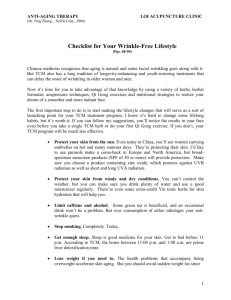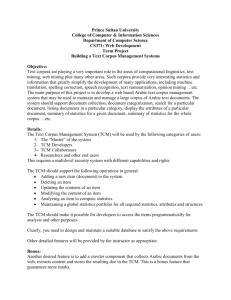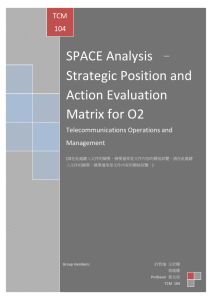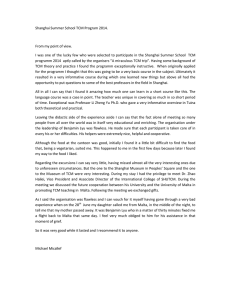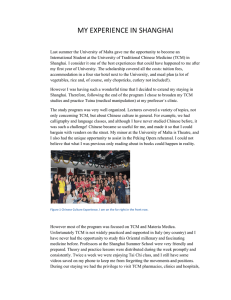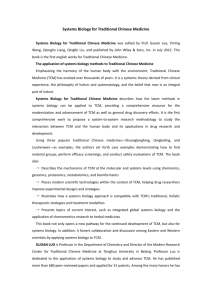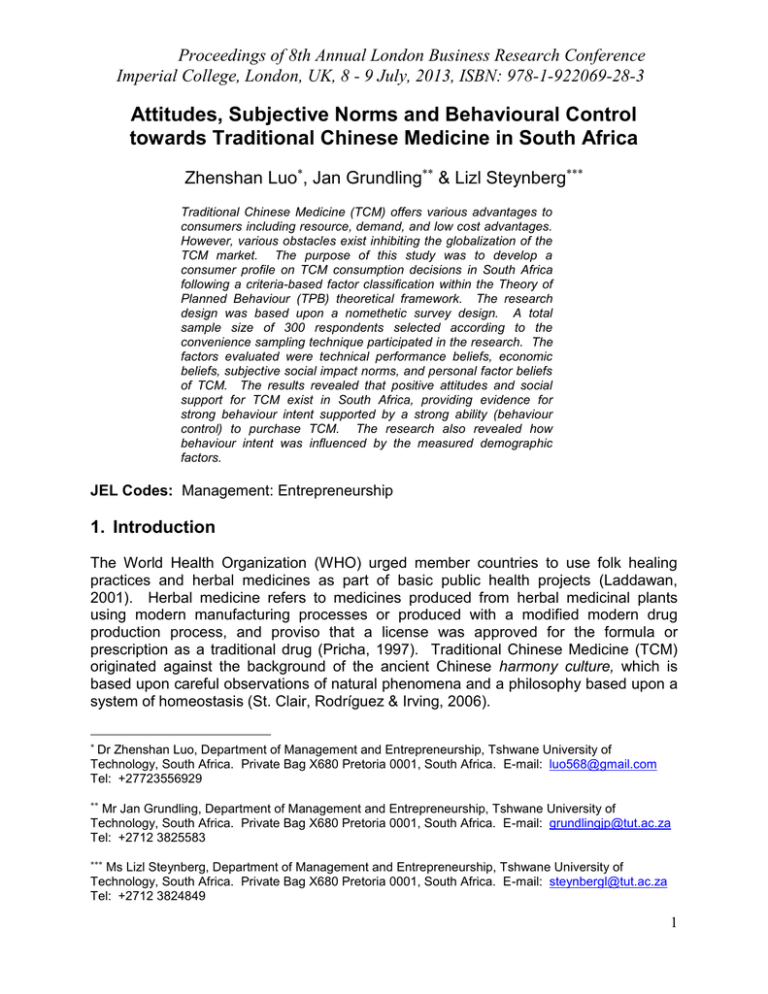
Proceedings of 8th Annual London Business Research Conference
Imperial College, London, UK, 8 - 9 July, 2013, ISBN: 978-1-922069-28-3
Attitudes, Subjective Norms and Behavioural Control
towards Traditional Chinese Medicine in South Africa
Zhenshan Luo, Jan Grundling & Lizl Steynberg
Traditional Chinese Medicine (TCM) offers various advantages to
consumers including resource, demand, and low cost advantages.
However, various obstacles exist inhibiting the globalization of the
TCM market. The purpose of this study was to develop a
consumer profile on TCM consumption decisions in South Africa
following a criteria-based factor classification within the Theory of
Planned Behaviour (TPB) theoretical framework. The research
design was based upon a nomethetic survey design. A total
sample size of 300 respondents selected according to the
convenience sampling technique participated in the research. The
factors evaluated were technical performance beliefs, economic
beliefs, subjective social impact norms, and personal factor beliefs
of TCM. The results revealed that positive attitudes and social
support for TCM exist in South Africa, providing evidence for
strong behaviour intent supported by a strong ability (behaviour
control) to purchase TCM. The research also revealed how
behaviour intent was influenced by the measured demographic
factors.
JEL Codes: Management: Entrepreneurship
1. Introduction
The World Health Organization (WHO) urged member countries to use folk healing
practices and herbal medicines as part of basic public health projects (Laddawan,
2001). Herbal medicine refers to medicines produced from herbal medicinal plants
using modern manufacturing processes or produced with a modified modern drug
production process, and proviso that a license was approved for the formula or
prescription as a traditional drug (Pricha, 1997). Traditional Chinese Medicine (TCM)
originated against the background of the ancient Chinese harmony culture, which is
based upon careful observations of natural phenomena and a philosophy based upon a
system of homeostasis (St. Clair, Rodríguez & Irving, 2006).
Dr Zhenshan Luo, Department of Management and Entrepreneurship, Tshwane University of
Technology, South Africa. Private Bag X680 Pretoria 0001, South Africa. E-mail: luo568@gmail.com
Tel: +27723556929
Mr Jan Grundling, Department of Management and Entrepreneurship, Tshwane University of
Technology, South Africa. Private Bag X680 Pretoria 0001, South Africa. E-mail: grundlingjp@tut.ac.za
Tel: +2712 3825583
Ms Lizl Steynberg, Department of Management and Entrepreneurship, Tshwane University of
Technology, South Africa. Private Bag X680 Pretoria 0001, South Africa. E-mail: steynbergl@tut.ac.za
Tel: +2712 3824849
1
Proceedings of 8th Annual London Business Research Conference
Imperial College, London, UK, 8 - 9 July, 2013, ISBN: 978-1-922069-28-3
TCM uphold balancing, uprighting and eliminating the pathogens principles of treating
diseases and maintaining health, rather than confrontation and killing methods to
conquer diseases (Peng, 2009). TCM puts the occurrence of diseases, climatic
changes, environmental variations, emotional fluctuations, imbalance of diet and life,
and the disorder of sex life together and therefore, TCM constituted a macro
methodology, distinguished from Western medicine which follows an exact microscopic
and pathologic anatomy methodology. It relies on inspection, listening, smelling, inquiry
and pulse-taking to experience and study human dynamic life information. Syndrome
differentiation guides disease treatment. As point of departure, TCM stresses disease
prevention rather than treatment. It treats diseases mainly with prescription and
acupuncture. TCM includes Chinese medical materials, traditional Chinese medicine
pills and proprietary Chinese medicines deriving mainly from original medications of
nature. Despite general agreement that TCM offers resource, demand, and low cost
advantages, various obstacles exist inhibiting the globalization of the TCM market.
Recently, South Africa has gained reputation in the world‟s health market, as home to
new natural remedies such as Redbush tea, Aloe ferox and Hoodia and embedded in a
herbal medicine tradition.
Homeopathic medicine is highly valued, with many
consumers preferring this treatment. Approximately 600-700 homeopathic practitioners
operate in the country whilst medical aid schemes have begun giving discounts on
medicine which have stimulated consumer spending. In South Africa the TCM market is
comparatively well-developed and the development can serve as a reference in
exploring the TCM market in other African countries and the world at large. In 2011,
TCM was officially incorporated into the health care system of South Africa (Forum on
China-Africa Cooperation, 2012).
2. Purpose of the Research
The purpose of this study was to develop a consumer profile of TCM consumption
decisions according to a criteria-based factor classification within the Theory of Planned
Behaviour (TPB) framework. The research could assist manufacturers, prospective and
established TCM entrepreneurs to adopt best approaches to promote the use of TCM.
The consumer behaviour profile could provide guidance on how to market TCM to nonChinese markets.
3. Theoretical Framework
The study was based upon the TPB of Icek Ajzen and the Structural Dimensions of
David Jobber. The TPB provides a link between beliefs and behaviour, whilst the
Structural Dimensions were used as attitude, subjective norms and behavioural control
dimensions for evaluating TCM in the TPB model.
The TPB – a multi-attribute attitude model – in general portray consumers‟ attitudes with
regard to an attitude object (TCM) as a function of their perception and assessment of
the key attributes or beliefs held to that particular attitude object. According to this
2
Proceedings of 8th Annual London Business Research Conference
Imperial College, London, UK, 8 - 9 July, 2013, ISBN: 978-1-922069-28-3
model “behaviour intention” best predicts actual behaviour and is influenced by both a
consumer‟s attitude towards the attitude object (TCM) as well as by subjective norms
which represents what the consumer thinks relevant others will think about the
anticipated action (Schiffman & Kanuk, 2004). For Ajzen (1991:181) intentions are
assumed to capture the motivational factors influencing behaviour and giving an
indication of people‟s willingness to try, given that a person at will can decide to perform
the behaviour or not due to opportunities and resources available. Thus opportunities
and resources provide a free will to perform and represent control over the behaviour.
Behaviour achievement depends jointly on motivation (intention) and ability (behavioural
control). It is assumed the stronger the intention, the higher the probability of
performing the behaviour. Three factors influence behaviour intent, namely attitude,
subjective norms, and perceived behavioural control. Whilst attitude represents a
disposition towards an object, subjective norms are perceptions of whether significant
others approve of a person‟s behaviour. Perceived behavioural control refers to
people‟s belief in their ability to perform a behaviour. When people belief in their ability
and have the related opportunities and resources, their perceived behavioural control in
performing the behaviour will be stronger (Ajzen, 1991; Madden, Ellen & Ajzen, 1992).
The TPB can be summarized as a predictive theoretical model for human behaviour that
assesses a person‟s belief towards a particular behaviour, belief about the social norms
associated with a particular behaviour, and a belief regarding the ability to control the
outcome of a particular behaviour (Alt & Lieberman, 2010).
The TPB also found support in the Andersen‟s Model of Health Service Utilisation which
identified three factors influencing health service utilization: a predisposing, an enabling
and a need component (Andersen, 1995; Goodwin & Andersen, 2002).
The
predisposing component represents the propensity of individuals to use medical
services and includes aspects like demographic factors, social structure, and health
beliefs. The enabling component refers to the external resources enabling individuals to
access medical care and include family income, health care insurance, and accessibility
to medical resources. The need component refers to the personal health needs of the
individual.
Liao, Ma and Chiu (2006) integrated the TPB and Andersen‟s Behaviour Model of
Health Service Utilation into a Pathway Model aimed at testing the factors that influence
Chinese medicine outpatients‟ behaviour patterns in purchasing TCM. The Pathway
Model consisted of five factors: suffering from disease, attitude toward TCM, TCM
knowledge, people‟s influence, and usable resources. These researchers assumed that
the five factors would influence behavioural intention toward purchasing TCM and actual
purchasing behaviour. Their empirical results indicated that improving a patient‟s
behavioural intention can stimulate their purchasing behaviour.
4. Research Design and Methods
The research design was based upon a nomethetic survey design, designed for the
South African context. A convenience sample of 300 respondents was selected from a
population of the Gauteng province, representing 10.2 million people older than 18
3
Proceedings of 8th Annual London Business Research Conference
Imperial College, London, UK, 8 - 9 July, 2013, ISBN: 978-1-922069-28-3
years of age. Respondents were selected from customers visiting South African
Chinese medicine stores during 2010. The only criteria for selection was that
respondents should be older than 18 years, and have willingness to give consent to
participate in the research.
According to the TPB attitude, subjective norms and perceived behavioural control
arose from salient beliefs. Salient beliefs according to Marcati, Guido and Peluso
(2013) represent all the mental associations between an object, or behaviour, and its
perceived attributes. The structural dimensions of Jobber (1995:745) were used as
attributes of TCM in a multi-choice, 5-point Likert-scale questionnaire:
Technical performance was evaluated in terms of product effectiveness, loyalty,
accessibility, side effects, durability, reliability, comfort and convenience of the
product;
Economic considerations was evaluated according to price, total cost of treatment,
value for money, and affordability;
Social impact evaluated the extent to which the customer was informed about the
benefits, effectiveness of marketing, exposure to TCM and the Chinese culture, and
motivation of consumers to promote TCM usage; and
Personal factors evaluated the personal profile of consumers, in particular their
intention to buy TCM.
Every statement was evaluated according to the following key:
1 = Strongly disagree;
2 = Tend to disagree;
3 = Neither agree nor disagree;
4 = Tend to agree; and
5 = Strongly agree
The hypothesis for each of the above attributes was formulated according to the
following general description:
H0: Each structural TCM attribute has the same effect on the selected sample groups.
Ha: Each structural TCM attribute has a significant different effect on the selected
sample groups.
One-way variance analysis (ANOVA) was used to compare different types of
consumers to test whether the means of the respondent groups are all equal or not
using the Statistical Package for Social Sciences (SPSS) version 16.
5. Findings
300 respondents participated of which 26.7% (n=80) were younger than 30 years,
28.3% (n=85) were between the ages 31-40, 29.0% (n=87) between the ages 41-50,
12.0% (n=36) between the ages 51-60, and 4.0% (n=12) were older than 60 years. Of
the total sample size, 57.3% (n=172) were male and 43.7% (n=128) female. The
4
Proceedings of 8th Annual London Business Research Conference
Imperial College, London, UK, 8 - 9 July, 2013, ISBN: 978-1-922069-28-3
majority respondents 58.0% (n=174) had tertiary education, 38.0% (n=114) secondary
education, and 4.0% (n=12) primary education.
Table 1: Technical Performance Beliefs of TCM in Demographic Factors
TCM Technical Performance beliefs
Comparative
TCM
effectiveness
Health
maintenance
Comparative
side
effects
Comparative
safety of
extracted
TCM
Advice
from
Chinese
medicine
doctor
Accessibility
of TCM
TCM not
covered by
medical aids
comparative
effectiveness
4.15
4.31
3.82
3.98
4.51
4.30
3.98
PS
4.07
0.390
3.872
0.532
1
4.00
4.26
4.05
4.22
4.08
0.742
2.402
0.563
4
4.00
4.29
0.022
3.872
0.880
1
4.41
4.20
4.34
4.19
4.25
0.519
2.402
0.721
4
4.17
3.59
2.030
3.872
0.155
1
3.67
3.68
3.70
3.86
4.08
0.349
2.402
0.844
4
3.92
3.87
0.867
3.872
0.352
1
3.83
3.94
4.01
3.92
4.08
0.386
2.402
0.818
4
3.92
4.31
2.829
3.872
0.093
1
4.45
4.46
4.41
4.39
4.33
0.059
2.402
0.993
4
424.
4.22
0.421
3.872
0.516
1
4.46
4.32
4.10
4.11
4.25
1.341
2.402
0.254
4
4.08
3.59
7.587
3.872
0.006**
1
3.65
3.69
3.93
4.08
4.17
1.458
2.402
0.214
4
3.92
SS
4.09
4.33
3.62
4.00
4.46
4.26
3.78
TE
4.14
4.29
3.78
3.89
4.40
4.29
3.83
0.156
3.026
0.855
2
4.17
0.154
3.026
0.856
2
4.36
0.559
3.026
0.571
2
3.71
0.364
3.026
0.694
2
3.99
0.130
3.026
0.877
2
4.51
0.202
3.026
0.816
2
4.32
0.105
3.026
0.900
2
3.86
4.15
4.40
3.83
3.71
4.31
4.10
3.75
4.13
4.50
3.50
4.23
4.27
4.40
3.77
0.371
3.026
0.689
2
4.09
4.22
2.235
3.026
0.108
2
4.28
4.51
0.665
3.026
0.514
2
3.74
3.82
3.386
3.026
0.035
2
3.95
4.09
1.533
3.026
0.217
2
4.39
4.56
1.413
3.026
0.244
2
4.19
4.44
0.268
3.026
0.764
2
3.83
3.85
4.10
4.18
3.58
3.74
4.40
4.34
3.71
0.281
1.452
0.491
1.646
0.611
1.216
0.300
Evaluation
Gender
m
f
F
Fk
p
df
18-30
31-40
Age
41-50
51-60
60+
Education
F
Fk
p
df
F
Fk
p
Df
100_
Employmen
t
Income
100500
500+
F
Fk
p
df
Empl
Sempl
Unempl
F
5
Proceedings of 8th Annual London Business Research Conference
Imperial College, London, UK, 8 - 9 July, 2013, ISBN: 978-1-922069-28-3
Fk
p
df
3.026
0/754
2
3.026
0.235
2
3.026
0.611
2
3.026
0.194
2
3.026
0.543
2
3.026
0.297
2
3.026
0.740
2
The majority of respondents (n=183; 61%) belonged to the low income group earning
less than R100 000 per annum, 29% (n=87) to the middle income group earning
between R100 001 and R500 000, whilst the minority 10% (n =30) to the high income
group earning more than R500 000 per annum. No significant differences between the
two genders could be identified on TCM perceived technical performance except that
they differ on perceptions that TCM not covered by medical aids are more effective than
other medicines. On this, males reported a significantly higher mean score than
females, indicating that females rely more on medical aid information than males to
decide on the effectiveness of medicine. Despite a positive perception, the middle
income group was more skeptical than other respondent groups that extracted TCM
preparations are safer than other medicine preparations. On all the demographic
factors respondents belief in the effectiveness of TCM, that it can be used for health
maintenance, has fewer side-effects than other medicines, that powder preparations are
safer than other medicine preparations, will accept the advice from a Chinese medicine
doctor, that TCM is accessible, and that some TCM is more effective than other
medicines even if it was not covered by a medical aid scheme. H0 should be partially
accepted that technical performance of TCM has the same effect on the selected
sample groups. H0 should be rejected for perceptions that TCM not covered by medical
aids are more effective than other medicines due to differences in perceptions between
genders, and that extracted TCM preparations are safer than other medicine
preparations due to differences in perceptions between income groups (Table 1).
TPB Table 2 provides an indication of the respondents‟ perceived ability (Behaviour
control) to procure TCM. No significant difference could be found between the two
genders regarding their perceptions on economic attributes of TCM. Despite the fact
that a general consensus existed TCM is affordable, cheaper than other medicine, low
income people can afford TCM, and TCM offers value for money, a significant
difference was identified between the age groups on the perception that TCM is
affordable. The younger the respondents, the more positive affordability were
evaluated, whilst the older the respondent, the lower was the perception of affordability.
A significant difference was also found on the statement “offering value for money”. The
lower educated respondents reported a much higher mean score than the secondary
and tertiary educated. A marginal significant difference was found in employment status
where the unemployed responded lower than the other two employment categories on
the same statement.
The higher income groups reported significantly higher
evaluations than the low income group on TCM is cheaper than other medicine, low
income groups can afford TCM, and TCM offers value for money. H0 should be partially
accepted that economic attributes of TCM has the same effect on the selected sample
groups. All the respondent categories indicated a positive evaluation on economic
attributes, that the higher income respondents have a higher perceived ability to buy
TCM than the lower income category, the younger respondents had a greater
propensity to consider TCM affordable than the older generations, and that the lower
6
Proceedings of 8th Annual London Business Research Conference
Imperial College, London, UK, 8 - 9 July, 2013, ISBN: 978-1-922069-28-3
the educational level of respondents the higher was the perceived offering value of
TCM.
Table 2: Economic Beliefs of TCM in Demographic Factors
TCM Economic beliefs
TCM in
general is
affordable
TCM is cheaper
than other
medicine
Low income
people can also
afford TCM
TCM offers
value for
money
m
4.40
4.12
4.23
4.35
f
4.32
4.19
4.27
4.16
0.467
3.872
0.495
1
4.50
4.38
4.36
4.33
3.50
2.601
2.401
0.036*
4
4.50
4.47
4.45
1.964
3.026
0.142
2
4.43
4.23
4.40
1.123
3.026
0.326
2
4.48
4.50
4.31
0.694
3.026
0.500
2
0.276
3.872
0.599
1
4.30
4.26
4.25
4.03
3.42
2.001
2.401
0.094
4
4.42
4.14
4.13
0.339
3.026
0.712
2
4.23
3.84
4.57
5.924
3.026
0.002**
2
4.17
4.20
4.15
0.146
3.026
0.863
2
0.127
3.872
0.721
1
4.36
4.19
4/37
4.08
3.50
2.008
2.401
0.082
4
4.50
4.38
4.27
0.522
3.026
0.593
2
4.34
3.97
4.50
4.231
3.026
0.015*
2
4.26
4.21
4.32
0.575
3.026
0.563
2
2.204
3.872
0.138
1
4.30
4.29
4.25
3.92
3.50
0.350
2.401
0.843
4
4.50
4.38
4.28
3.054
3.026
0.048*
2
4.34
4.02
4.57
3.939
3.026
0.020*
2
4.40
4.58
4.19
2.907
3.026
0.050
2
Gender
Evaluation
F
Fk
p
df
18-30
31-40
Age
41-50
51-60
60+
F
Fk
p
df
Education
PS
SS
TE
F
Fk
p
df
Income
100_
100-500
500+
F
Fk
p
df
Employment
Empl
Sempl
Unempl
F
Fk
P
df
7
Proceedings of 8th Annual London Business Research Conference
Imperial College, London, UK, 8 - 9 July, 2013, ISBN: 978-1-922069-28-3
According to the Pathway Model of Liao, Ma and Chiu (2006) people‟s influence impact
on the behavioural intention and will eventually influence the purchasing behaviour of a
person. Table 3 reveals that on all four statements the social impact on behavioural
intention was positive with female respondents, respondents younger than 60 years,
and the well and low educated respondents reporting a significantly higher average
mean that family members and relatives were using TCM. The age group above 60
years was either not sure or tend to disagree that family members and relatives were
using TCM. The low and well educated respondents reported stronger agreement that
family members and relatives have received satisfactory results using TCM than
secondary school respondents.
Table 3: Social Beliefs of TCM in Demographic Factors
TCM Subjective Social Impact Norms
Motivation
to comply
Gender
m
f
F
Fk
p
df
18-30
31-40
Age
41-50
51-60
60+
F
Fk
p
df
Education
PS
SS
TE
F
Fk
p
df
100-500
500+
F
Fk
p
df
E
m
p
l
o
y
m
e
n
t
Income
100_
Empl
Encouragement
by family
members to
purchase TCM
3.88
4.05
1.272
3.872
0.260
1
3.97
4.10
3.94
3.89
3.08
1.683
2.402
0.153
4
4.08
3.82
4.04
1.088
3.026
0.338
2
4.04
3.72
4.10
2.001
3.026
0.137
2
3.99
Family
members/relatives
have used TCM
Family members
want me to
purchase TCM
3.73
4.05
3.75
3.95
Family
members/relatives
have received
satisfactory results
3.88
4.13
4.447
1.548
3.872
0.214
1
3.74
3.85
3.92
3.98
3.08
1.323
2.402
0.261
4
4.17
3.81
3.83
0.389
3.026
0.667
2
3.88
3.69
3.97
0.750
3.026
0.472
2
3.87
2.887
3.872
0.090
1
3.95
3.96
4.14
3.92
3.50
0.832
2.402
0.505
4
4.42
3.77
4.09
3.051
3.026
0.048*
2
4.07
3.79
4.00
1.465
3.026
0.232
2
3.97
3.872
0.035
1
3.69
3.98
3.98
4.08
2.83
2.729
2.402
0.029*
4
4.42
3.59
4.01
4.362
3.026
0.013*
2
3.88
3.84
3.83
0.045
3.026
0.955
2
3.88
8
Proceedings of 8th Annual London Business Research Conference
Imperial College, London, UK, 8 - 9 July, 2013, ISBN: 978-1-922069-28-3
Sempl
Unempl
F
Fk
p
df
4.04
3.79
0.667
3.026
0.513
2
4.16
3.56
2.975
3.026
0.050
2
4.00
3.58
1.584
3.026
0.206
2
4.29
3.76
2.719
3.026
0.067
2
Table 4: Personal Factor Beliefs of TCM in Demographic Factors
TCM Personal Factor beliefs
Motivational
Outcomes
Gender
m
f
F
Fk
p
df
18-30
31-40
Age
41-50
51-60
60+
F
Fk
p
df
Education
PS
SS
TE
F
Fk
p
df
100_
Employment
Income
100-500
500+
F
Fk
p
df
Empl
Sempl
Unempl
F
Fk
It is easy to make
decoctions from
TCM herbs
I have time to make
decoctions from
TCM herbs
It is difficult to find a
hospital offering
TCM products
3.86
3.98
0.710
3.872
0.399
1
3.94
3.92
3.94
3.94
3.42
0.488
2.402
0.744
4
4.17
3.95
3.87
0.369
3.026
0.691
2
4.00
3.70
4.10
1.749
3.026
0.175
2
3.88
3.80
4.10
0.683
3.026
3.77
3.89
0.692
3.872
0.405
1
3.96
3.89
3.88
3.72
3.58
0.675
2.402
0.609
4
4.00
3.88
3.77
0.370
3.026
0.690
2
3.87
3.65
3.97
1.105
3.026
0.332
2
3.81
3.80
3.87
0.131
3.026
3.63
3.67
0.068
3.872
0.793
1
3.68
3.78
3.87
3.47
3.67
0.880
2.402
0.476
4
3.92
3.77
3.56
0.897
3.026
0.408
2
3.29
3.23
4.03
5.374
3.026
0.005**
2
3.62
3.71
3.69
0.065
3.026
As far as traffic is
concerned, it is
difficult to find a
hospital offering
TCM products
3.48
3.48
0.000
3.872
0.991
1
3.33
3.32
3.68
3.47
4.25
1.537
2.402
0.191
4
3.67
3.62
3.38
0.954
3.026
0.386
2
3.48
3.59
4.07
2.910
3.026
0.050
2
3.43
3.62
3.52
0.855
3.026
9
Proceedings of 8th Annual London Business Research Conference
Imperial College, London, UK, 8 - 9 July, 2013, ISBN: 978-1-922069-28-3
p
df
0.505
2
0.877
2
0.936
2
0.426
2
No significant differences were found between the different income groups, or
employment status groups on the dimension social impact of TCM. All the groups
reported a positive social impact of TCM, implying a positive impact on behavioural
intent. It can be concluded that respondents‟ gender, education and age influenced
their perceptions on how social factors influence their perceptions on TCM. H 0 can
therefore only be partially accepted.
Table 4 reveals that significant differences on personal factor beliefs relating to TCM
except for income. The respondents were in agreement that it is easy to make
decoctions from TCM herbs, have the time to make decoctions, is relatively difficult to
find a hospital offering TCM products, and due to traffic it is difficult to find a hospital
offering TCM products. The high income respondents differed significantly from the
other income groups as they find it harder to find hospitals offering TCM hospitals. H 0
should therefore only partially been accepted.
6. Conclusion and Recommendations
The partial rejection of H0 on all four structural dimensions implies that the TCM
variables had different effects on some of the sample groups and not on the others. It
can be concluded that because the attitudes towards TCM as well as the beliefs that
significant others would approve the use and purchasing of TCM were evaluated as
high, the intention to buy TCM products will be high. The economic considerations also
indicated that the participants were of the opinion that they have the ability (Behaviour
control) to purchase TCM. The South African market therefore represents a favourable
market for TCM products.
The results can be summarized as:
Attitude towards TCM was influenced by the demographic factors gender and
income levels of respondents. The differentiating factor between the two genders
could be attributed towards a greater dependency of females on medical information
to evaluate the effectiveness of TCM. The middle income group also differentiate
themselves from all the other income groups in terms of a greater skepticism on the
safety of TCM preparations. The high income groups also found it difficult to locate
hospitals offering TCM products. Attitudes towards the performance of TCM can be
enhanced by providing comprehensive information on the effectiveness of TCM, the
safety of TCM preparations as well as offering information on where TCM products
can be found. The two factors in technical performance of TCM on which the gender
and income determinants had an influence can be considered confidence factors
that according to research done by Winston and Patel (1995) ranked higher than
financial considerations in deciding to purchase a product or not. It is recommended
that the middle income groups and the female group in the middle income segment,
which represent a significant market in South Africa, be selected as a separate
10
Proceedings of 8th Annual London Business Research Conference
Imperial College, London, UK, 8 - 9 July, 2013, ISBN: 978-1-922069-28-3
market segment and that the marketing campaign should try to strengthen
confidence in the technical performance of TCM.
The Subjective norms (Approval) were influenced by the demographic variables
gender, age and education. Respondents younger than 60 years, females, and the
well and low educated respondents reported that family members and relatives were
using TCM. The low and well educated respondents also reported stronger
agreement that family members and relatives have received satisfactory results
using TCM than secondary school respondents. It can be concluded that in this
market segment motivations to purchase TCM will comply with an expected positive
response from significant others.
Behavioural control was primarily influenced by the demographic variables age,
education, income and employment status. The younger the respondents the
greater emphasis was placed on affordability of TCM, whilst the older respondents
placed lesser emphasis on affordability. A significant difference was also found in
the respondents on TCM perceptions as it relates to offering value for money. The
lower educated seems to be less critical on the value offered for money than better
educated secondary and tertiary respondents. Employed and self-employed
respondents also evaluated this component higher than unemployed respondents.
The higher and middle income groups viewed TCM as cheaper than other
medicines, affordable, and offering value for money. It can be concluded that the
perceived ability of South African consumers to purchase TCM and therefore to
exert behaviour control was evaluated as positive.
The two most important demographic factors that influenced attitudes toward TCM
and behavioural control was income whilst the subjective norm of approval was
mostly influenced by the demographic factor education.
How lucrative and what market size of the medicine market TCM will be able to occupy
will in the end be determined by the extent to which TCM and Western medicine
philosophy and practices can co-exist and the extent to which TCM is accepted in the
core medical profession in South Africa.
References
Ajzen, I 1991, The theory of planned behavior, Organizational Behavior and Human
Decision Processes, Vol. 50, pp. 179-211.
Alt, JK and Lieberman, S 2010, „Modeling the theory of planned behavior from survey
data for action choice in social simulations‟, In: Proceedings of the 19th
Conference on Behavior Representation in Modeling and Simulation, Charleston,
SC, pp 126-133.
11
Proceedings of 8th Annual London Business Research Conference
Imperial College, London, UK, 8 - 9 July, 2013, ISBN: 978-1-922069-28-3
Andersen, RM 1995, Revisiting the behavioral model and access to medical care: Does
it matter?, Journal of Health and Social Behavior, Vol. 36, pp. 1-10.
Forum on China-Africa Cooperation, 2012, Traditional Chinese Medicine and pharmacy
- TCM in Africa: Opportunities and challenges, [online] Available at:
http://www.focac.org/eng/zxxx/t933043.htm [Accessed 20 June 2012].
Goodwin, R and Andersen, RM, 2002, Use of the behavioral model of health care use to
identify correlates of use of treatment for panic attacks in the community, Social
Psychiatry and Psychiatric Epidemiology, Vol. 37, No. 5, pp. 212-219.
Jobber, D, 1995, Principles and practice of marketing. New York: McGraw-Hill
Education.
Laddawan, B, 2001, Current situations of herbs. In: O. Phraeratkul, ed. 2001. Training
on herbal knowledge its batch. Prah Nakhon Sri Ayutthaya: Rajabhat Institute,
Prah Nakhon Sri Ayutthaya Press.
Liao, HL, Ma, TC and Chiu, YL 2006, A study on consumer behavior and its related
factors in traditional Chinese herbal stores in Taiwan area, Journal of Healthcare
Management, Vol. 7, No. 3, pp. 323-341.
Madden, TJ, Ellen, PS and Ajzen, I 1992, A comparison of the theory of planned
behavior and the theory of reasoned action, Personality and Social Psychology
Bulletin, Vol. 18, pp. 3-9.
Marcati, A, Guido, G and Peluso, AM 2013, What is marketing for SME entrepreneurs?
The need to market the marketing approach, [online] Available at:
http://www.escp-eap.net/conference/marketing/2008_cp/materiali/paper/it/
Marcati_Guido_Peluso.pdf [Accessed 4 April 2013].
Peng, J 2009, The advantages of Traditional Chinese Medicine in the current medical
field, [online] Available from: http://www.tcmtreatment.com/tcm-teaching/
advantages-tcm.htm [Accessed 18 April 2013].
Pricha, S 1997, Research report on food and drug purchasing behaviors of housewives
in urban and country areas, Nontaburi: Office of the Thai Food and Drug
Administration.
Schiffman, LG and Kanuk, LL 2004, Consumer behavior, New Jersey: Pearson Prentice
Hall.
St. Clair, RN, Rodríguez, AMR and Irving, GJ 2006, Intercultural incommensurability
and the globalization of Chinese Medicine: The case of acupuncture, The Journal
of Comparative Asian Development, Vol. 5, No. 1, pp. 199-211.
12
Proceedings of 8th Annual London Business Research Conference
Imperial College, London, UK, 8 - 9 July, 2013, ISBN: 978-1-922069-28-3
Winston, CM and Patel, V 1995, Use of traditional and Orthodox health services in
urban Zimbabwe, International Journal of Epidemiology, Vol. 24, No. 5, pp. 10061012.
13

